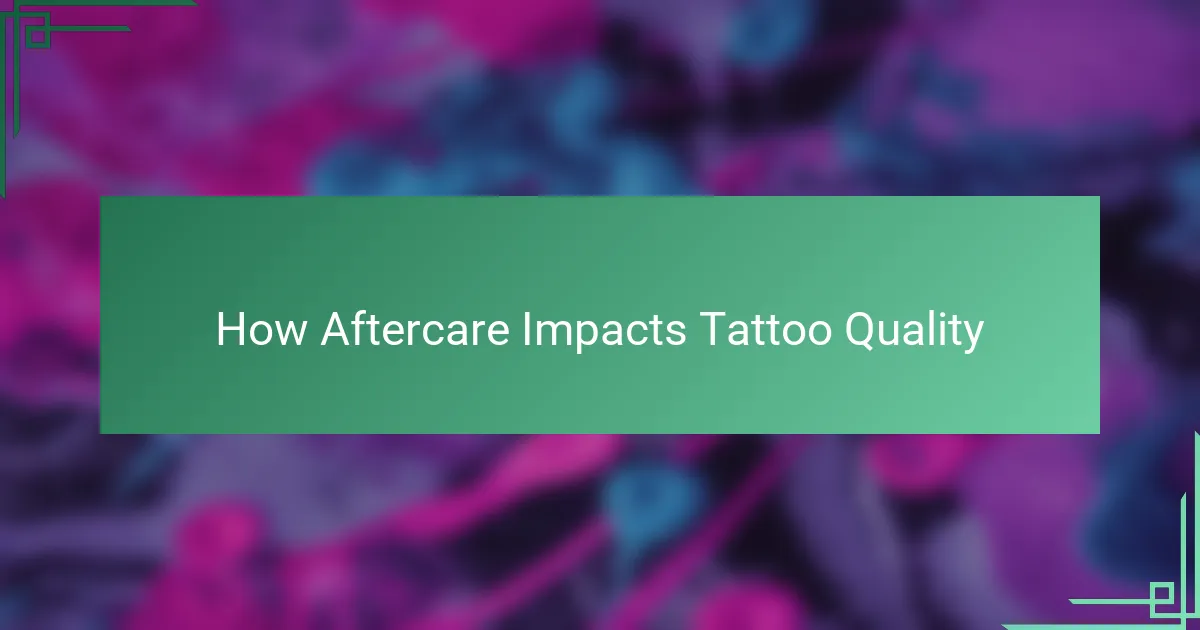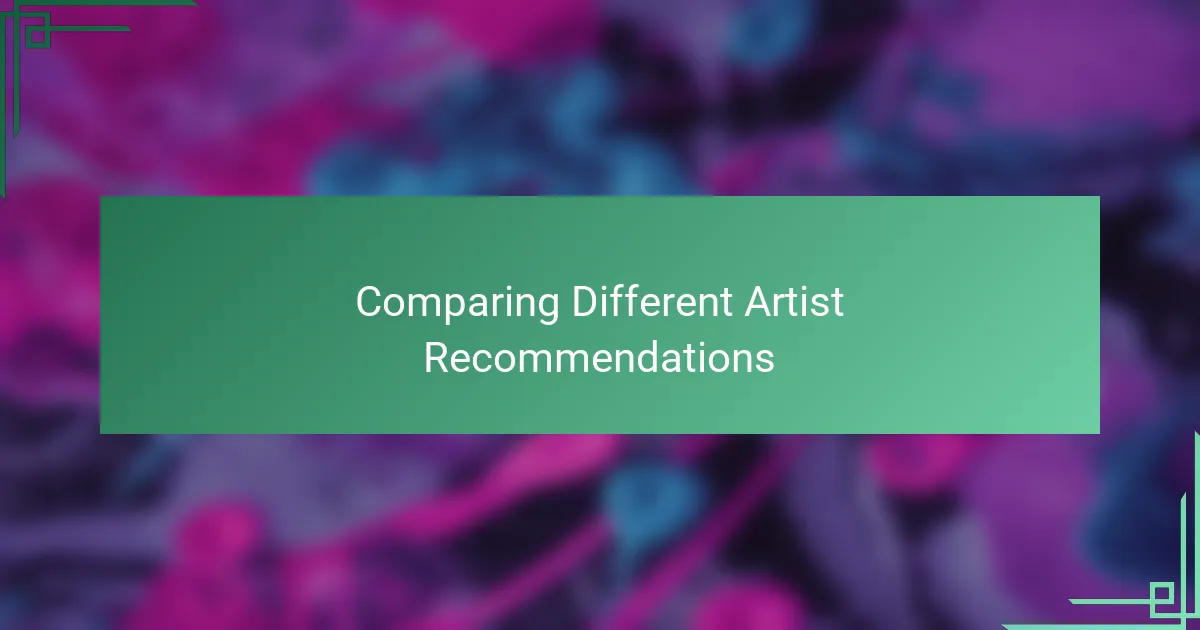Key takeaways
- Proper tattoo aftercare is crucial for preserving the tattoo’s appearance and the longevity of the artwork.
- Common aftercare practices include gentle cleaning, regular moisturizing, and sun protection to prevent fading.
- Aftercare is a personalized process; it requires tuning into your skin’s needs and adjusting methods accordingly.
- Consistency in aftercare routines significantly impacts the healing process and the final quality of the tattoo.

Understanding Tattoo Aftercare Importance
When I first got my tattoo, I underestimated how crucial aftercare truly is. It felt like just a few small steps, but I quickly learned that neglecting them could turn a piece of art into a painful blotch. Have you ever thought about how this simple routine preserves not just the tattoo but also your confidence in showing it off?
The skin is an amazing canvas, but it’s also delicate and prone to infection or fading if not treated properly. I realized that following my artist’s advice wasn’t just about avoiding harm—it was about respecting the work they put into my tattoo and honoring my own body. Don’t we all want our tattoos to look vivid for years, not just weeks?
Sometimes, I think aftercare is the quiet hero of every great tattoo story. Without it, all the time and trust invested can unravel. It makes me wonder: how much do we really appreciate the behind-the-scenes care that transforms a fresh tattoo into a lifelong masterpiece?

Common Aftercare Tips from Artists
Most artists I’ve talked to emphasize gentle cleaning as step one. They usually advise washing the tattoo with lukewarm water and mild, fragrance-free soap. I remember the nervousness in my hands the first time I did this — the key is to be soft and patient, not rough or hurried. Have you noticed how that simple, careful washing already feels like you’re protecting a fragile treasure?
Another common tip I’ve heard is to always keep the tattoo moisturized but not too slick. Applying a thin layer of a recommended ointment or lotion multiple times a day helps the skin heal without cracking or drying out. I found that this balance is tricky — too much product and it gets sticky, too little and the skin tightens painfully. Have you ever felt that tight, itchy discomfort creeping in when you skipped moisturizing?
Lastly, almost every artist warned me about sun exposure. They stressed covering the tattoo or using high SPF once the area is healed to prevent fading. It made me rethink my usual carefree sunbathing habits because a tattoo is more than just skin deep; it’s a symbol you want to protect. Doesn’t it make you appreciate how aftercare extends the life of your body art far beyond the chair?

How Aftercare Impacts Tattoo Quality
Seeing how closely aftercare influences tattoo quality changed my whole perspective. I learned the hard way that a brilliant design can become dull and patchy if the skin doesn’t heal properly. Have you ever noticed how skipping just one of those aftercare steps can make your tattoo look like it’s been through a rough storm rather than a fresh piece of art?
The way your skin responds during healing tells you a lot about the final outcome. When I was diligent about moisturizing and protecting my tattoo, the colors stayed sharp and the lines crisp. On the other hand, when I was careless even once, I saw how quickly scabbing and peeling could distort the fine details. Doesn’t that make you realize that aftercare isn’t just a chore—it’s part of the artistry?
I also find it fascinating how aftercare impacts not only the visual quality but the longevity of a tattoo. A well-healed tattoo ages gracefully, while neglect often leads to premature fading and blurring. It’s like investing in your tattoo’s future, ensuring it remains a vibrant story on your skin for years to come. Have you thought about aftercare as a lifelong commitment rather than just a healing phase?

Personal Experience with Aftercare Practices
When I got my first tattoo, I was surprised at how much time aftercare took—more than I expected, but every moment felt worthwhile. I remember waking up each day checking for any redness or irritation, worried that I might have slipped up somewhere. Have you ever found yourself obsessively watching your skin’s progress, hoping you didn’t miss a step?
One time, I accidentally applied too much ointment and ended up with an uncomfortable, sticky mess that clogged my pores. It taught me that aftercare isn’t just about following instructions blindly but listening to what your skin actually needs. Isn’t it interesting how the best care comes from tuning in and adjusting as you go along?
I’ve noticed that when I’m consistent—washing gently, moisturizing just right, and avoiding the sun—it feels like I’m nurturing more than just a tattoo; I’m nurturing a part of myself. That sense of responsibility made me respect not only the art but also the artist who trusted me with their creation. Have you ever felt that connection growing deeper each day you care for your tattoo?

Comparing Different Artist Recommendations
What struck me most when comparing different artists’ aftercare advice was how varied their approaches can be, even when aiming for the same goal: a well-healed tattoo. Some recommended frequent moisturizing with specific ointments, while others cautioned against overdoing it to avoid clogged pores. Have you ever wondered why these contradictions exist, and which advice to trust for your unique skin type?
I’ve noticed that the tone and detail of recommendations often reflect an artist’s experience and the style of their work. One artist might stress the importance of keeping the tattoo dry, while another encourages gentle exposure to air for better healing. This made me realize that aftercare isn’t one-size-fits-all; it’s tailored, much like the art itself. Doesn’t that personalized touch make the process feel more collaborative and thoughtful?
Interestingly, when I followed aftercare tips from multiple artists, I found combining their advice required some trial and error. For example, balancing moisture without clogging pores meant I had to adjust product amounts and timing based on how my skin reacted. Have you experienced that moment when you realize aftercare is as much about listening to your body as it is about following instructions?

Practical Aftercare Steps I Follow
For me, the first practical step is always the gentle wash. I take my time with lukewarm water and a mild, fragrance-free soap, almost like I’m handling a newborn—delicate and careful. Have you ever noticed how that softness actually sets the tone for the whole healing process? It’s not just cleaning; it feels like a small act of respect for my tattoo.
Moisturizing is where the challenge lies. I learned early on that slathering too much ointment turns into an uncomfortable, sticky layer that traps sweat and irritates my skin. Now, I aim for a thin, even spread, just enough to keep the tattoo hydrated without smothering it. Doesn’t that balancing act make you realize how attuned you have to be to your body’s signals during healing?
Sun protection quickly became non-negotiable for me. Even after the initial healing phase, I religiously apply high SPF or cover my tattoo to prevent fading. It’s like a promise I make—to preserve the art and the story it carries. Have you caught yourself reconsidering your sun habits once you understood how vulnerable fresh ink really is?

Advice for Choosing Aftercare Methods
Choosing the right aftercare method often feels overwhelming because there’s no universal solution that fits everyone. I remember being puzzled by all the product options and conflicting advice—how do you pick what truly works for your skin? The key, I found, is to consider your own skin type and sensitivities first; what soothes dry skin might irritate oily or acne-prone skin, so personalizing aftercare is essential.
Another thing I learned is to trust the artist’s recommendations but also stay flexible. Sometimes I started with one product and noticed my skin reacted poorly, so I switched to something gentler or changed application frequency. Doesn’t it make sense to treat aftercare like a conversation with your body rather than a strict rulebook?
Lastly, I’ve realized that consistency beats perfection. It’s better to apply a moderate amount of ointment regularly than to overdo it once and neglect it the rest of the day. When I committed to a steady routine, my healing process improved drastically, and so did the final look of my tattoo. Have you noticed how small, thoughtful habits can shape a lasting result?


